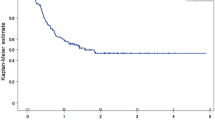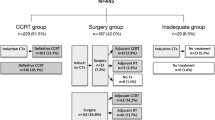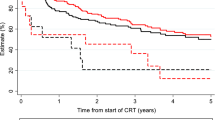Abstract
Introduction
Squamous cell carcinomas of the head and neck (SCCHN) account for approximately 4% of all malignancies and are associated with high morbidity and poor prognosis. For patients who are not eligible for surgery or radiotherapy, treatment options are limited, especially for those with recurrent or metastatic (R/M) disease. Current European guidelines recommend first-line (1L) treatment with palliative chemotherapy, using biologic or platinum-based regimens. In the absence of new clinical trials in SCCHN, the use of real-world data has facilitated the assessment of treatment patterns and outcomes in different healthcare systems. This study reports on the 1L treatment of platinum-eligible patients with R/M SCCHN in Italy and Spain.
Methods
A point-in-time survey of the management of patients with R/M SCCHN was completed by clinical oncologists in Italy and Spain between October 2018 and February 2019. Patient demographics and clinical characteristics were obtained by retrospective chart review, whilst participating patients self-reported the impact of their disease on their quality of life (QoL) and well-being.
Results
A total of 436 patients were recruited from Italy (216) and Spain (220). Patient demographics for both countries comprised mostly male patients, aged 65 years in Italy and 63 in Spain on average. The primary site for the SCCHN was the pharynx and 36% of patients had metastatic disease overall. EXTREME or cetuximab-based regimens were the most common treatments administered at 1L (52% in Italy and 78% in Spain). Scores on the FACT-G in both countries were substantially lower than those of the general and other advanced cancer populations, while scores on the EQ-5D were clinically meaningfully lower than local population norms.
Conclusion
Despite 1L treatment of platinum-eligible patients with R/M SCCHN in Italy and Spain following current European guidelines, patients’ QoL remains poor, which highlights the need for alternative treatments that could improve clinical outcomes.



Similar content being viewed by others
References
Bray F, Ferlay J, Soerjomataram I, Siegel RL, Torre LA, Jemal A. Global cancer statistics 2018: GLOBOCAN estimates of incidence and mortality worldwide for 36 cancers in 185 countries. CA Cancer J Clin. 2018;68(6):394–424.
Marur S, Forastiere AA. Head and neck squamous cell carcinoma: update on epidemiology, diagnosis, and treatment. Mayo Clin Proc. 2016;91(3):386–96.
Guidi A, Codecà C, Ferrari D. Chemotherapy and immunotherapy for recurrent and metastatic head and neck cancer: a systematic review. Med Oncol. 2018;35(3):37.
Bean MB, Liu Y, Jiang R, et al. Small cell and squamous cell carcinomas of the head and neck: comparing incidence and survival trends based on surveillance, epidemiology, and end results (SEER) data. Oncologist. 2019;24(12):1562–9.
Cohen RB, Delord J-P, Doi T, et al. Pembrolizumab for the treatment of advanced salivary gland carcinoma: findings of the phase 1b KEYNOTE-028 study. Am J Clin Oncol. 2018;41(11):1083–8.
Boscolo-Rizzo P, Zorzi M, Del Mistro A, et al. The evolution of the epidemiological landscape of head and neck cancer in Italy: is there evidence for an increase in the incidence of potentially HPV-related carcinomas? PLoS ONE. 2018;13(2):e0192621.
Diz P, Meleti M, Diniz-Freitas M, et al. Oral and pharyngeal cancer in Europe: incidence, mortality and trends as presented to the Global Oral Cancer Forum. Transl Res Oral Oncol. 2017;2:1–13.
La EM, Smyth EN, Talbird SE, et al. Treatment patterns and health care resource use in patients receiving multiple lines of therapy for metastatic squamous cell carcinoma of the head and neck in the United Kingdom. Eur J Cancer Care (Engl). 2018;27(5):e12862.
Grégoire V, Lefebvre JL, Licitra L, Felip E, EHNS-ESMO-ESTRO Guidelines Working Group. Squamous cell carcinoma of the head and neck: EHNS-ESMO-ESTRO Clinical Practice Guidelines for diagnosis, treatment and follow-up. Ann Oncol. 2010;21 Suppl 5:v184–6.
NICE. Cancer of the upper aerodigestive tract: assessment and management in people aged 16 and over: NICE Guideline [NG 36]. https://www.nice.org.uk/guidance/ng36. 2016.
Mehanna H, Kong A, Ahmed SK. Recurrent head and neck cancer: United Kingdom National Multidisciplinary Guidelines. J Laryngol Otol. 2016;130(S2):S181–90.
Specenier P, Vermorken JB. Optimizing treatments for recurrent or metastatic head and neck squamous cell carcinoma. Expert Rev Anticancer Ther. 2018;18(9):901–15.
Argiris A, Bauman JE, Ohr J, et al. Phase II randomized trial of radiation therapy, cetuximab, and pemetrexed with or without bevacizumab in patients with locally advanced head and neck cancer. Ann Oncol. 2016;27(8):1594–600.
Vermorken JB, Mesia R, Rivera F, et al. Platinum-based chemotherapy plus cetuximab in head and neck cancer. N Engl J Med. 2008;359(11):1116–27.
Lynggaard CD, Therkildsen MH, Kristensen CA, Specht L. The EXTREME regimen for recurrent/metastatic head and neck squamous cell carcinoma (R/M HNSCC): treatment outcome in a single institution cohort. Acta Oncol. 2015;54(7):1071–5.
Licitra L, Mesía R, Keilholz U. Individualised quality of life as a measure to guide treatment choices in squamous cell carcinoma of the head and neck. Oral Oncol. 2016;52:18–23.
Singer S, Arraras JI, Baumann I, et al. Quality of life in patients with head and neck cancer receiving targeted or multimodal therapy–update of the EORTC QLQ-H&N35, Phase I. Head Neck. 2013;35(9):1331–8.
Melo Filho MRd, Rocha BA, Pires MBdO, et al. Quality of life of patients with head and neck cancer. Braz J Otorhinolaryngol. 2013;79(1):82–8.
Rigoni L, Bruhn RF, De Cicco R, Kanda JL, Matos LL. Quality of life impairment in patients with head and neck cancer and their caregivers: a comparative study. Braz J Otorhinolaryngol. 2016;82(6):680–6.
Byrne K, Zanotti G, Hallworth P, et al. Real-world treatment patterns and outcomes of patients with stage IV squamous cell carcinoma of the head and neck. Future Oncol. 2019;15(6):611–23.
Grünwald V, Chirovsky D, Cheung WY, et al. Global treatment patterns and outcomes among patients with recurrent and/or metastatic head and neck squamous cell carcinoma: results of the GLANCE H&N study. Oral Oncol. 2020;102:104526.
Lafuma A, Cotté F-E, Le Tourneau C, et al. Economic burden of chemotherapy-treated recurrent and/or metastatic squamous cell carcinoma of the head and neck in France: real-world data from the permanent sample of national health insurance beneficiaries. J Med Econ. 2019;22(7):698–705.
van der Linden N, Buter J, Pescott CP, et al. Treatments and costs for recurrent and/or metastatic squamous cell carcinoma of the head and neck in the Netherlands. Eur Arch Otorhinolaryngol. 2016;273(2):455–64.
Anderson P, Benford M, Harris N, Karavali M, Piercy J. Real-world physician and patient behaviour across countries: disease-specific programmes - a means to understand. Curr Med Res Opin. 2008;24(11):3063–72.
Medeiros BC, Pandya BJ, Hadfield A, et al. Treatment patterns in patients with acute myeloid leukemia in the United States: a cross-sectional, real-world survey. Curr Med Res Opin. 2019;35(5):927–35.
von Moos R, Body J-J, Rider A, et al. Bone-targeted agent treatment patterns and the impact of bone metastases on patients with advanced breast cancer in real-world practice in six European countries. J Bone Oncol. 2017;11:1–9.
Wood R, Mitra D, de Courcy J, Iyer S. Patient-reported pain severity, pain interference and health status in HR+/HER2- advanced/metastatic breast cancer. ESMO Open. 2017;2(3):e000227.
Whynes DK. Correspondence between EQ-5D health state classifications and EQ VAS scores. Health Qual Life Outcomes. 2008;6:94.
D’Antonio LL, Zimmerman GJ, Cella DF, Long SA. Quality of life and functional status measures in patients with head and neck cancer. Arch Otolaryngol Head Neck Surg. 1996;122(5):482–7.
Calvert M, Kyte D, Mercieca-Bebber R, et al. Guidelines for inclusion of patient-reported outcomes in clinical trial protocols: the SPIRIT-PRO extension. JAMA. 2018;319(5):483–94.
van Hout B, Janssen MF, Feng Y-S, et al. Interim scoring for the EQ-5D-5L: mapping the EQ-5D-5L to EQ-5D-3L value sets. Value Health. 2012;15(5):708–15.
Janssen MF, Szende A, Cabases J, Ramos-Goñi JM, Vilagut G, König HH. Population norms for the EQ-5D-3L: a cross-country analysis of population surveys for 20 countries. Eur J Health Econ. 2019;20(2):205–16.
Brucker PS, Yost K, Cashy J, Webster K, Cella D. General population and cancer patient norms for the Functional Assessment of Cancer Therapy-General (FACT-G). Eval Health Prof. 2005;28(2):192–211.
Holzner B, Kemmler G, Cella D, et al. Normative data for functional assessment of cancer therapy–general scale and its use for the interpretation of quality of life scores in cancer survivors. Acta Oncol. 2004;43(2):153–60.
Webster K, Cella D, Yost K. The Functional Assessment of Chronic Illness Therapy (FACIT) measurement system: properties, applications, and interpretation. Health Qual Life Outcomes. 2003;1:79.
Szende A, Janssen B, Cabases J, editors. Self-reported population health: an international perspective based on EQ-5D. Dordrecht: Springer; 2014. p. 19–30.
Pearman T, Yanez B, Peipert J, Wortman K, Beaumont J, Cella D. Ambulatory cancer and US general population reference values and cutoff scores for the functional assessment of cancer therapy. Cancer. 2014;120(18):2902–9.
Ringash J, Bezjak A, O’Sullivan B, Redelmeier DA. Interpreting differences in quality of life: the FACT-H&N in laryngeal cancer patients. Qual Life Res. 2004;13(4):725–33.
Pickard AS, Neary MP, Cella D. Estimation of minimally important differences in EQ-5D utility and VAS scores in cancer. Health Qual Life Outcomes. 2007;5:70.
Hallworth P, Simpson S, Bennett B, et al. Are there differences in Fact-G scores between different tumour types for an EU population using real world data? Value Health. 2017;20(9):A456.
Acknowledgements
Medical writing support under the guidance of the authors was provided by K. Ian Johnson, BSc SRPharmS, Harrogate House, Macclesfield, UK, on behalf of Adelphi Real World, and was funded by Bristol-Myers Squibb, in accordance with Good Publication Practice guidelines (Ann Intern Med 2015;163:461-464).
Authorship
All named authors meet the International Committee of Medical Journal Editors (ICMJE) criteria for authorship for this article, take responsibility for the integrity of the work as a whole, and have given their approval for this version to be published.
Author Contributions
All authors affiliated with Adelphi Real World were involved in 1) study conception, design, analysis and interpretation of data; 2) drafting and revising the article; 3) providing intellectual content of critical importance to the work described; and 4) final approval of the version to be published. All authors affiliated with Bristol Myers Squibb were involved in 1) questionnaire design and interpretation of data; 2) reviewing and revising the article; and 3) final approval of the version to be published.
Funding
Data collection was undertaken by Adelphi Real World as part of an independent survey, entitled the Adelphi SCCHN DSP™, sponsored by multiple pharmaceutical companies of which one was Bristol-Myers Squibb. Bristol-Myers Squibb did not influence the original survey through either contribution to the design of questionnaires or data collection. The study described here was funded by Bristol-Myers Squibb. The journal’s Rapid Service Fee was funded by Adelphi Real.
Disclosures
Prianka Singh, Marta Contente, Bryan Bennett, Luigi Zarrelli and Carlos Polanco Sanchez are employees of, and may hold shares in, Bristol-Myers Squibb. Jennifer Hall, Hollie Bailey and Abigail Bailey are employees of the Adelphi Real World, a company that received research funding for the current study.
Compliance with Ethics Guidelines
The DSP utilises solely retrospective data collection and no identifiable protected health information was extracted during the course of the study. The DSP protocol and all questionnaires used in the DSP were approved by the Western Institutional Review Board. Due to the nature of the research, this did not require gaining ethical approval in accordance with EphMRA, however ethical approval was submitted to an International Review Board and they granted a certificate of exemption for this study. Consent to participate was collected from physicians and patients by selecting “yes” to take part following information on the survey and use of data.
Data Availability
All data supporting the study are the intellectual property of Adelphi Real World and can be made available on request.
Author information
Authors and Affiliations
Corresponding author
Rights and permissions
About this article
Cite this article
Singh, P., Contente, M., Bennett, B. et al. Real-World Treatment Patterns and Outcomes in Patients with Head and Neck Cancer: Point-in-Time Survey of Oncologists in Italy and Spain. Adv Ther 38, 4722–4735 (2021). https://doi.org/10.1007/s12325-021-01851-2
Received:
Accepted:
Published:
Issue Date:
DOI: https://doi.org/10.1007/s12325-021-01851-2




